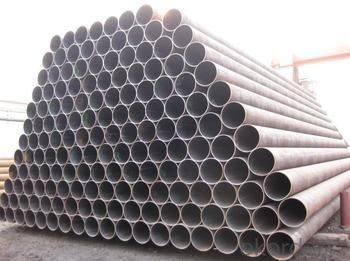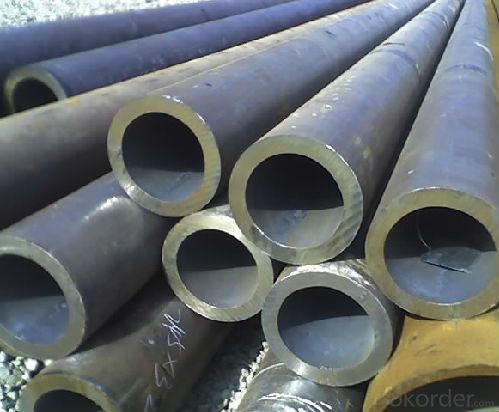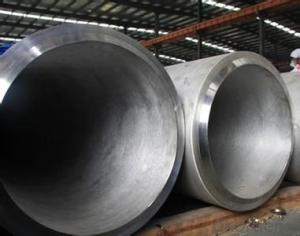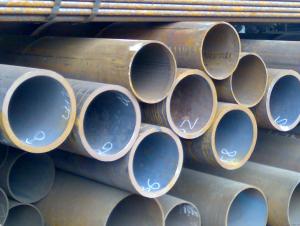API 5L Thick Wall Seamless Stainless Steel Tube
- Loading Port:
- Tianjin
- Payment Terms:
- TT or LC
- Min Order Qty:
- 25 m.t.
- Supply Capability:
- 10000 m.t./month
OKorder Service Pledge
OKorder Financial Service
You Might Also Like
We are company that have many years experience and professional manager team and engineer team and sales team, sure we will provide you high quality of pipe and professioanl service.
Seamless pipe possesses a hollow section and without seam around the strip steel. It is made with solid bar or steel ingot by perforating machine. As the facture process does not include any welding, seamless pipes are considered to be stronger and more durable. Generally speaking, seamless pipe has better pressure resistance and security than other classifications, and was usually more easily available than welded pipe.
2、Main Features of the Seamless Pipe:
• High working accuracy
• High strength
• Small inertia resistance
• Strong therming dissipine ability
• Good appearance
• Reasonble price
3、Seamless Pipe Specification:
Standard | GB, DIN, ASTM ASTM A106-2006, ASTM A53-2007 |
Grade | 10#-45#, 16Mn 10#, 20#, 45#, 16Mn |
Thickness | 8 - 33 mm |
Section Shape | Round |
Outer Diameter | 133 - 219 mm |
Place of Origin | Shandong, China (Mainland) |
Secondary Or Not | Non-secondary |
Application | Hydraulic Pipe |
Technique | Cold Drawn |
Certification | API |
Surface Treatment | factory state or painted black |
Special Pipe | API Pipe |
Alloy Or Not | Non-alloy |
Length | 5-12M |
Outer Diameter | 21.3-610mm |
Grade | 20#, 45#, Q345, API J55, API K55, API L80, API N80, API P110, A53B |
Standard | ASME, ASTM |
1) Material:20#(ASTM A 106/A53 GRB.API5LGRB,GB),45#,16Mn,10#.
2) Specification range: OD: 21.3-610mm, WT:6-70mm, length:6-12m or according to the requirement of clients.
3) Executive standards: GB, ASME API5L.ASTM A 106/A53,Despite of the above standards, we can also supply seamless steel pipe with standard of DIN, JIS, and so on, and also develop new products according to the requirements of our clients!
4) Surface: black lacquered, varnish coating or galvanized.
5) Ends: Beveled or square cut, plastic capped, painted.
6) Packing: bundles wrapped with strong steel strip, seaworthy packing.
4、Packaging & Delivery:
Packaging Details: | seaworthy package, bundles wrapped with strong steel strip |
Delivery Detail: | 15-30days after received 30%TT |
5、FAQ of Seamless Pipe:
①How is the quality of your products?
We have many years business experience in this area, and we have professional engineer and manager team and sure we can provide you high quality production and professional service.
②How about price?
Yes, we are factory and be able to give you lowest price below market one, and we have a policy that “ for saving time and absolutely honest business attitude, we quote as lowest as possible for any customer, and discount can be given according to quantity”,if you like bargain and factory price is not low enough as you think, just don’t waste your time.Please trust the quotation we would give you, it is professional one.
③Why should you chose us?
We can give you both.Additionally, we can also offer professional products inquiry, products knowledge train(for agents), smooth goods delivery, exellent customer solution proposals.Our service formula: good quality+good price+good service=customer’s trust
SGS test is available, customer inspection before shipping is welcome, third party inspection is no problem.
6、Seamless Pipe Images:


- Q:How do stainless steel pipes compare to ductile iron pipes?
- Stainless steel pipes and ductile iron pipes have different characteristics and applications. Stainless steel pipes offer excellent corrosion resistance, making them suitable for various industries, including food processing and chemical plants. On the other hand, ductile iron pipes are known for their strength and durability, making them commonly used in water distribution systems and sewer lines. Ultimately, the choice between stainless steel and ductile iron pipes depends on the specific needs and requirements of the project or application.
- Q:How do you prevent stainless steel pipes from corroding?
- There are several measures that can be taken to prevent corrosion in stainless steel pipes: 1. The selection of the appropriate grade of stainless steel is crucial. Each grade has varying levels of corrosion resistance, so it is important to choose a grade that is suitable for the specific environment in which the pipes will be used. For environments that are more corrosive, it is recommended to use higher grades such as 316 stainless steel. 2. Proper installation and maintenance are essential. Ensuring that the pipes are installed correctly with the appropriate gaskets, seals, and fittings will prevent any gaps or leaks that could allow moisture or corrosive substances to enter. Regular inspections and maintenance should be conducted to identify and repair any damage or potential sources of corrosion. 3. Keeping the pipes clean and dry is important. Regular cleaning will remove any contaminants or corrosive substances that may have accumulated. It is important to avoid using harsh chemical cleaners that can harm the protective oxide layer on the surface of the stainless steel. Additionally, prolonged exposure to water or moisture should be avoided to keep the pipes dry and prevent corrosion. 4. The application of protective coatings can provide an additional layer of protection against corrosion. There are specific coatings or paints designed for stainless steel that act as a barrier, preventing direct contact between the stainless steel and corrosive substances. 5. In highly corrosive environments, cathodic protection can be utilized. This involves the use of sacrificial anodes or impressed current systems to divert the electrical current away from the pipes, thus protecting the stainless steel from corrosion. By following these preventive measures, the risk of corrosion in stainless steel pipes can be significantly reduced, leading to a longer lifespan for the pipes.
- Q:What is the difference between nominal size and actual size in stainless steel pipes?
- The nominal size of a stainless steel pipe refers to the designated size used for identification purposes, while the actual size represents the true dimensions of the pipe. Nominal size is typically indicated by a number, such as 1/2 inch or 2 inches, but the actual size may differ slightly due to manufacturing tolerances.
- Q:Can stainless steel pipes be used in underground installations?
- Yes, stainless steel pipes can be used in underground installations. Stainless steel is known for its corrosion resistance, which makes it a suitable material for underground applications where pipes are exposed to moisture and other corrosive elements. Stainless steel pipes are durable, long-lasting, and can withstand high pressure and extreme temperatures. Additionally, stainless steel is also resistant to damage from underground soil movements. Therefore, it is a reliable choice for underground installations such as water and gas supply systems, sewage systems, and industrial pipelines.
- Q:Can stainless steel pipes be used for food processing equipment?
- Stainless steel pipes have the capability to be utilized for food processing equipment. The food industry highly favors stainless steel due to its ability to resist corrosion, its durability, and its hygienic properties. It does not interact with food or beverages, guaranteeing the absence of contamination or alteration of the product. In addition, stainless steel pipes are easily cleaned and maintained, making them an ideal option for use in food processing equipment where cleanliness and food safety are crucial. Furthermore, stainless steel has the capacity to endure high temperatures and pressures, which are often necessary in food processing operations. In conclusion, stainless steel pipes are a suitable choice for food processing equipment and are extensively employed in the industry.
- Q:What is the maximum wall thickness for stainless steel pipes?
- The maximum wall thickness for stainless steel pipes can vary depending on the specific grade of stainless steel and the intended application. However, in general, stainless steel pipes can have a maximum wall thickness ranging from 0.065 inches (1.65 mm) to 3 inches (76.2 mm) or even more in certain cases. It is important to consult the appropriate industry standards, codes, or specifications for the specific grade of stainless steel being used to determine the maximum allowable wall thickness for a given application.
- Q:What is the difference between electropolished and passivated stainless steel pipes?
- Electropolished and passivated stainless steel pipes are both surface treatments used to enhance the corrosion resistance and aesthetic appearance of stainless steel. However, there are some key differences between the two processes. Electropolishing is an electrochemical process that selectively removes a thin layer of material from the stainless steel surface. This process helps to remove impurities, contaminants, and embedded particles, resulting in a smooth and clean surface. Electropolishing also improves the microfinish of the stainless steel, reducing surface roughness and enhancing the overall appearance. This process can also improve the corrosion resistance of stainless steel by creating a passive chromium oxide layer on the surface. On the other hand, passivation is a chemical process that involves the application of an acid-based solution to the stainless steel surface. This solution helps to remove iron contaminants and other foreign substances from the surface, leaving behind a clean and passive layer of chromium oxide. Passivation helps to enhance the corrosion resistance of stainless steel by promoting the formation of a stable and protective oxide layer. In summary, electropolishing is an electrochemical process that removes a thin layer of material to create a smooth and clean surface, while passivation is a chemical process that removes contaminants and promotes the formation of a protective oxide layer. Both processes contribute to improving the corrosion resistance and aesthetics of stainless steel pipes, but they differ in the method used to achieve these results.
- Q:Can stainless steel pipes be annealed?
- Stainless steel pipes possess the capability to undergo annealing, a process involving the heating of these pipes to a specific temperature, followed by a gradual cooling, which effectively alleviates stress, enhances ductility, and improves the mechanical properties of the material. Throughout the annealing process, the stainless steel pipes are heated to a temperature surpassing their recrystallization point, typically ranging from 1040°C to 1120°C (1904°F to 2048°F) for austenitic stainless steels. Consequently, this permits the internal structure of the pipes to achieve greater uniformity, thus relieving any stresses that may have been incurred during manufacturing or prior usage. Subsequently, post-annealing, the stainless steel pipes will exhibit improved formability, heightened toughness, and reduced hardness, rendering them suitable for a diverse range of applications across industries such as oil and gas, chemical processing, and construction.
- Q:Can stainless steel pipes handle acidic or alkaline fluids?
- Stainless steel pipes possess the ability to accommodate both acidic and alkaline fluids. Their exceptional corrosion resistance, a renowned attribute of stainless steel, renders them highly suitable for managing aggressive substances. This notable quality stems from the presence of chromium, which interacts with oxygen and generates a thin protective layer on the steel's surface, effectively halting further corrosion. This passive layer remains steadfast in both acidic and alkaline environments, furnishing long-lasting protection against corrosive fluids. However, the level of corrosion resistance may fluctuate depending on the specific stainless steel grade employed, as well as the fluid's concentration and temperature during transport. Consequently, it becomes crucial to meticulously select the appropriate stainless steel grade and duly consider factors like temperature, concentration, and potential exposure to other corrosive substances when opting for stainless steel pipes for the handling of acidic or alkaline fluids.
- Q:Stainless steel welded pipe or seamless pipe expensive?
- Stainless steel is generally divided into three categories: martensitic stainless steel, ferritic stainless steel, austenitic stainless steel, duplex stainless steel and precipitation hardening stainless steel. The price is roughly the same order as stainless steel. But each category has a cheaper and more expensive one, and the difference can be great.
1. Manufacturer Overview |
|
|---|---|
| Location | |
| Year Established | |
| Annual Output Value | |
| Main Markets | |
| Company Certifications | |
2. Manufacturer Certificates |
|
|---|---|
| a) Certification Name | |
| Range | |
| Reference | |
| Validity Period | |
3. Manufacturer Capability |
|
|---|---|
| a)Trade Capacity | |
| Nearest Port | |
| Export Percentage | |
| No.of Employees in Trade Department | |
| Language Spoken: | |
| b)Factory Information | |
| Factory Size: | |
| No. of Production Lines | |
| Contract Manufacturing | |
| Product Price Range | |
Send your message to us
API 5L Thick Wall Seamless Stainless Steel Tube
- Loading Port:
- Tianjin
- Payment Terms:
- TT or LC
- Min Order Qty:
- 25 m.t.
- Supply Capability:
- 10000 m.t./month
OKorder Service Pledge
OKorder Financial Service
Similar products
New products
Hot products
Hot Searches
Related keywords





























